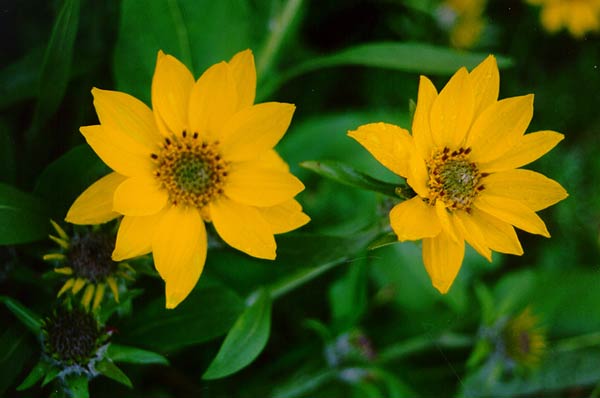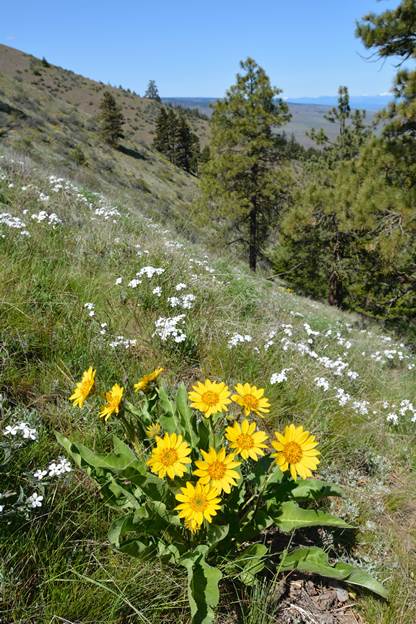“after dinner we proceeded on our voyage. I walked on Shore with Shabono on the N. Side through a handsome bottom. met Several parties of women and boys in Serch of herbs & roots to Subsist on maney of them had parcels of the Stems of the Sun flower [arrow-leaf balsamroot]. I joined Capt. Lewis and the party at 6 miles, at which place the river washed the bottom of high Clifts on the N. side. – William Clark, April 14, 1806, on the White Salmon River, WA.
This is a fairly common plant of the sunflower family (Asteracae) in cold, dry areas of the West. Its range extends from the Sierra Nevada west to Colorado and north into Canada. It can be found on open slopes or beneath conifer trees. It is typically found on medium-textured soils in areas with 12 – 25 inches of annual precipitation and at elevations from 1,000 – 9,000 ft.
Like the rest of the sunflowers the “flowers” are inflorescences made up of lots of tiny flowers (florets). The plant is in bloom typically between May and July depending on elevation, location in the range, and aspect. The plant gets its name from arrowhead-shaped leaves that can be up to 8 inches long. The leaf blades are fuzzy on the upper side.

The plant has a deep, thick taproot and can be as wide as your hand. The thicker sections of the root are covered by bark. Most parts of the plant were used by food by Native Americans. The roots can be baked or steamed and then eaten while young shoots of the plant are tender when cooked. Immature flower stems are peeled and eaten. The seeds are oil-rich and nutritious and the root can be used as a coffee substitute. Latin, Balsamorhiza – literally balsam root, and sagittata – arrow shaped.
Balsamroot survives fire quite well because of its hardy and persistent tap root, which can extend up to 8 feet deep. The first collection, likely made by William Clark, was on April 14, 1806 along the Columbia River in present-day Washington. Pursh’s label for these plants reads, “The stem is eaten by the natives, without any preparation. On the Columbia. Aprl. 14th 1806.” The second collection was made in Montana near Lewis & Clark Pass, as noted above. Pursh’s label for these fragments says, ” Rocky mountains. Dry hills Jul. 7th 1806.” The flowers collected in April are still in bloom, while the ones from the July date in Montana contain fully mature seeds.

Memorial Day weekend is a good time to go looking for these early bloomers on the east side of the Cascades in Washington. You can find them in open Ponderosa pine forests or on more open sagebrush slopes. A hike along Manastash Ridge out of Thorpe or along Umtanum Creek in the Yakima Canyon are good bets to run into this species. Heads up though – there is Hooker’s balsamroot that has a finer leaf pattern and wooly mule’s ear – which is often confused with balsamroot but has a broader and fuzzier leaf. Good luck plant hunting.
